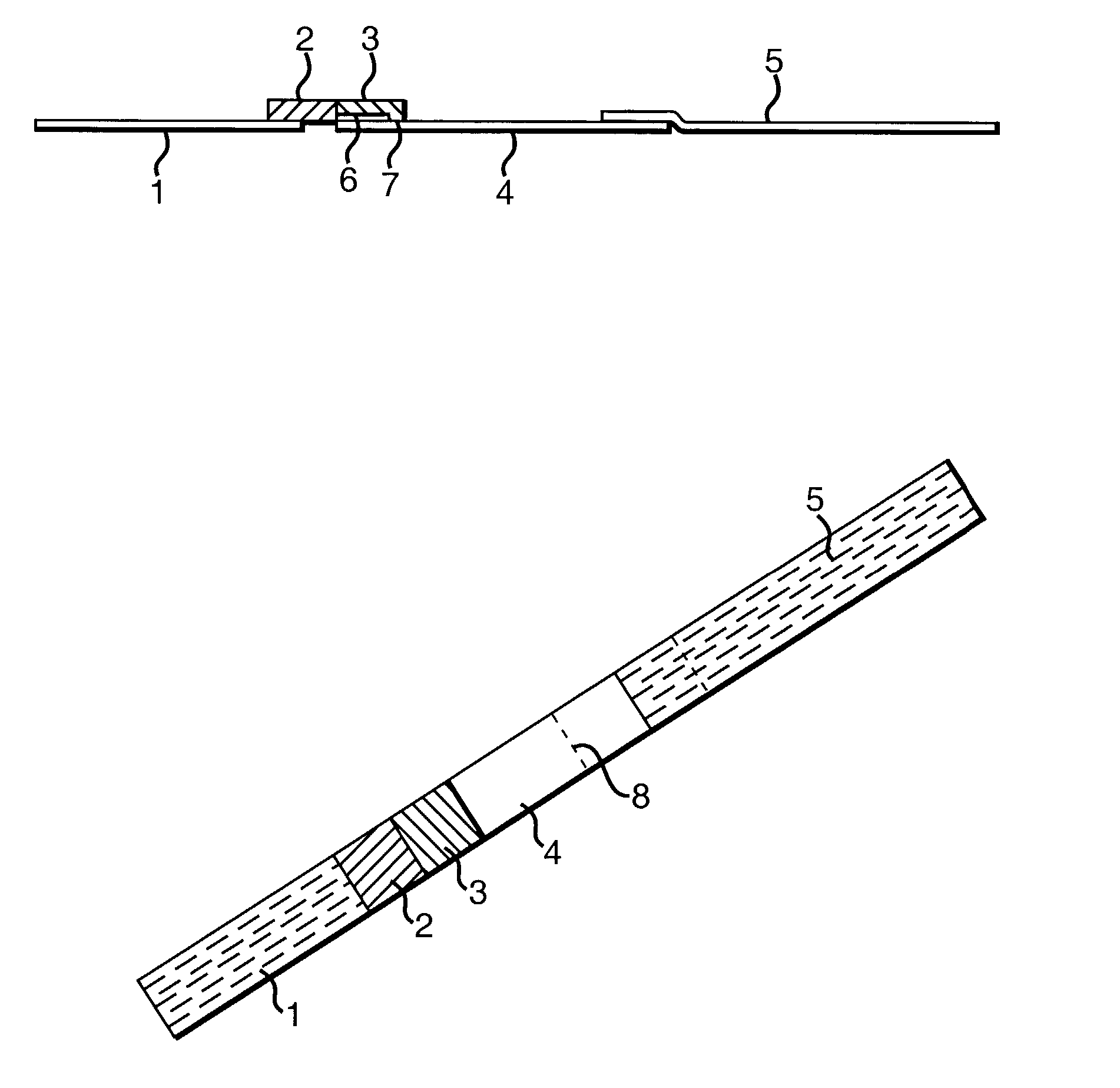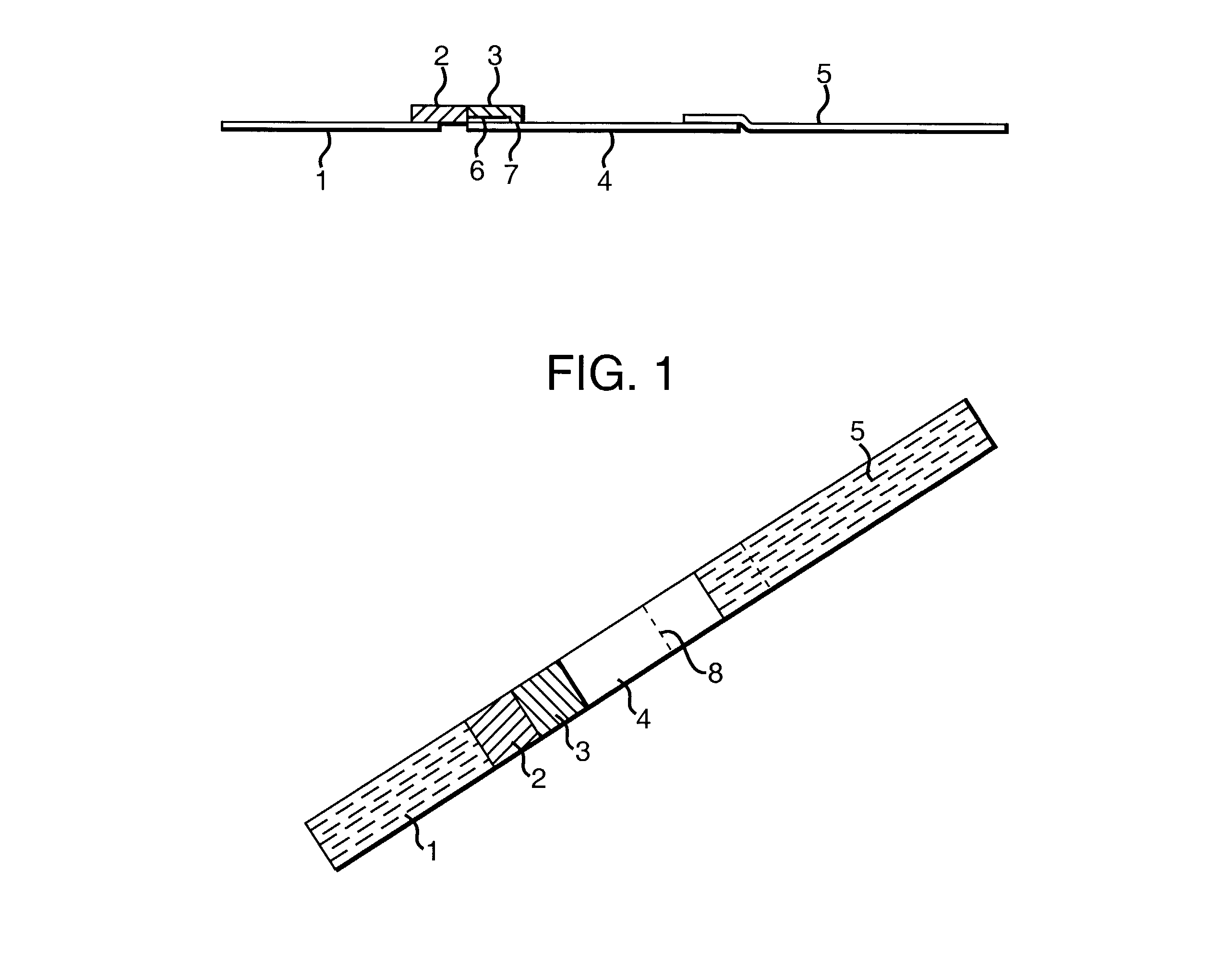Assay using porosity-reduction to inhibit migration
a technology of porosity reduction and migration inhibition, applied in the field of assay devices, can solve the problems of difficult manufacturing quality control, inability to manufacture nitrocellulose, and inability to homogeneous, and achieve the effect of simple and cheap production
- Summary
- Abstract
- Description
- Claims
- Application Information
AI Technical Summary
Benefits of technology
Problems solved by technology
Method used
Image
Examples
example 1
A Basic Lateral Flow Test Device
[0029] The device shown in FIG. 1 comprises a strip of filter paper (1), a first absorbent pad (2) containing gold-labelled anti-spermatozoa labelling antibody, a second absorbent pad (3) for receiving a sperm-containing sample, a nitrocellulose membrane (4), and an upper wick (5). Between the absorbent pad (3) and the nitrocellulose membrane (4) is a thin acetate strip (6) which prevents contact between the pad (3) and membrane (4) except for a narrow margin (7). Membrane (4) includes a line (8) of immobilised antibody which can react with unbound anti-sperm labelling antibody.
[0030] The nitrocellulose membrane (4) measures 5 mm.times.25 mm, and is mounted on a stiff plastic backing measuring 5 mm.times.73 mm. At one end of the membrane (4), upper wick (5), measuring 5 mm.times.30 mm, is attached such that they overlap by 5 mm, and at the other end a thin acetate strip (6) measuring 5 mm.times.4 mm is affixed. Absorbent pad (3), measuring 5 mm.times....
example 2
Qualitative Sperm Testing
[0034] In a test experiment, two samples were tested--the first was a sample of motile spermatozoa in HEPES buffer (obtained by indirect swim up from the ejaculate of a fertile man), and the second was just HEPES buffer. 75 .mu.l of each sample was placed on the absorbent pad (3) of two separate devices, and these were placed in separate wells, each containing 75 .mu.l HEPES.
[0035] After 15 minutes, the device used with the first sample had developed two clear red lines on membrane (4), the first about 1 mm above the absorbent pad (3), the second at line (8). The other device, however, contained a single red line at line (8). The device is thus able to capture spermatozoa mechanically around the `choking zone`.
example 3
Quantitative Sperm Testing
[0036] In a further experiment, a sample of motile spermatozoa in HEPES buffer was obtained by indirect swim up from the ejaculate of a fertile man. The number of motile sperm per ml in the HEPES portion of the swim up was established using a counting chamber and found to be 3.5 million. This sample was diluted with HEPES to give four further samples with 2, 1, 0.5 and 0.25 million sperm per ml respectively. 75 .mu.l of each of these five samples were placed on the absorbent pads (3) of five separate devices and these were placed in separate wells containing 75 .mu.l HEPES. Buffer alone was used as a control.
[0037] After 15 minutes, each of the devices had developed two clear red lines on membrane (4), the first about 1 mm above the absorbent pad (3), the second at line (8). As clearly shown in FIG. 2, however, the intensity of the first line decreased as the number of spermatozoa in the sample decreased by dilution. No first line was visible on the control...
PUM
| Property | Measurement | Unit |
|---|---|---|
| pore size | aaaaa | aaaaa |
| pore size | aaaaa | aaaaa |
| pore size | aaaaa | aaaaa |
Abstract
Description
Claims
Application Information
 Login to View More
Login to View More - R&D
- Intellectual Property
- Life Sciences
- Materials
- Tech Scout
- Unparalleled Data Quality
- Higher Quality Content
- 60% Fewer Hallucinations
Browse by: Latest US Patents, China's latest patents, Technical Efficacy Thesaurus, Application Domain, Technology Topic, Popular Technical Reports.
© 2025 PatSnap. All rights reserved.Legal|Privacy policy|Modern Slavery Act Transparency Statement|Sitemap|About US| Contact US: help@patsnap.com



